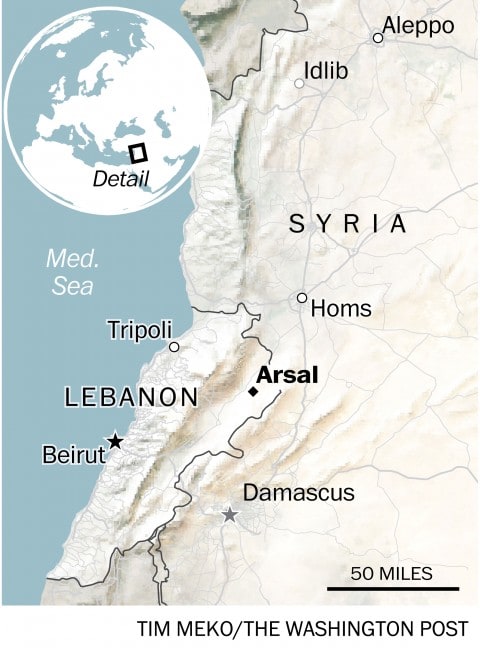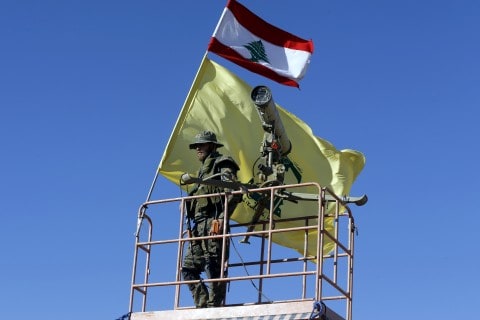JAROUD ARSAL, Lebanon — When President Trump lumped the Lebanese Hezbollah movement together with the Islamic State and al-Qaeda last week, describing Lebanon’s government as a partner in the fight against all of them, he might not have realized quite how complicated the situation in Lebanon is.
So on Saturday, Hezbollah took a party of journalists on a tour that helped explain, trumpeting the results of the militia’s recent fight against Syria’s al-Qaeda affiliate in barren mountains near the northeastern Lebanese town of Arsal.
The arduous trek into the rocky terrain underscored the sway the Iran-backed Hezbollah exerts in Lebanon, where it remains the most effective and best-armed military force and retains the ability to strike at will almost anywhere in the country.
It also illuminated the complexity of the political and military landscape in Lebanon — a U.S. ally, whose government includes Hezbollah, which is in turn branded a terrorist organization by Washington. Whether the Trump administration can navigate the pitfalls of this complexity may determine if this tiny, relatively calm country can continue to escape the turmoil raging elsewhere in the Middle East.
Trump’s comment was made alongside Lebanese Prime Minister Saad Hariri, who was on a visit to the United States to seek U.S. support. “Lebanon is on the front lines in the fight against ISIS, al-Qaeda and Hezbollah,” Trump said, without apparently realizing that Hariri struck an alliance with Hezbollah late last year to secure his appointment as prime minister.

The comment coincided with the conclusion of a two-week offensive by Hezbollah in the Arsal area that drove out scores of al-Qaeda-affiliated fighters belonging to the group known as Jabhat al-Nusra, as well as well as several hundred former Free Syrian Army rebels — whose allies until recently had received support from the United States.
Hezbollah officials said they took journalists on the tour to demonstrate that Hezbollah, not the United States, is the one doing most of the fighting against terrorism.
“The current American president is ignorant of the region,” said Hezbollah spokesman Mohammed Afif, speaking to reporters in a cave until recently occupied by Nusra. “We are the force that fights terrorism while the United States continues to support terrorism in many forms.”
Guided by a vanguard of Hezbollah officials in black-windowed armored vehicles, a convoy comprising over 40 journalists’ four-wheel-drive vehicles set out Saturday from the nearby Bekaa Valley and trundled slowly up a rocky mountain into the area where the battles took place.
There were frequent mishaps. Vehicles got bogged down in the rock-strewn dust. Sections of the convoy lost their way in the featureless wilderness. One group came within 200 yards of Syria before being hurriedly turned around by Hezbollah guides. A U.S.-manufactured Polaris All Terrain Vehicle driven by Hezbollah fighters acted as sheepdog to the unwieldy convoy, scooting over the most unnavigable stretches of rock to help journalists who were stuck or heading in the wrong direction.
The first stop was at the complex of caves and tunnels where Afif spoke, and where, Hezbollah officials said, Nusra fighters had holed up for years before they were ousted last week.
Identifiable only by an unobtrusive hole in the rocks, the complex extended unexpectedly deep into the mountain and included a kitchen, a row of toilets, a variety of rooms apparently used as sleeping quarters and offices, and a number of prison cells where, Hezbollah said, Lebanese hostages had been kept.

A Hezbollah fighter stands at a watchtower at the site where clashes erupted between Hezbollah and Al Qaeda-linked fighters in al-Kheil Valley in the Lebanon-Syria border on Saturday. (Bilal Hussein/AP)
There was also a sizable assembly room where a Hezbollah commander identified as Haj Abu Ahmed delivered a PowerPoint presentation outlining the different stages of the battle on colored maps. “They were based here, and they were defeated here,” he said of the Nusra fighters. “They were confronted by Karbala, Lebanon and the resistance,” he added, referring to the 8th century battle in Iraq in which adherents of the Shiite branch of Islam were vanquished by a Sunni army.
The cave was followed by visits to outposts where the rebel and Nusra fighters had maintained positions during the three years in which they took refuge from Syrian Army and Hezbollah advances just across the border, bringing a tiny slice of Syria’s war into this remote corner of Lebanon.
Nowhere was there any evidence of the Lebanese state, which has struggled to assert its role in the years since the 1975-1990 civil war saw the country overrun by scores of private militias. Only Hezbollah survived intact, retaining its status because of the role it played resisting what was then the Israeli occupation of a big chunk of southern Lebanon.
For the most part, the area is empty, an arid wilderness of ungoverned space devoid of habitation. Hezbollah outposts, flying yellow Hezbollah flags alongside those of Lebanon, are few and far between. Tents labeled as belonging to the Iranian Red Crescent are erected at some of the posts, presumably to supply medical aid to the fighters. There is no sign of its Lebanese equivalent.
But Hezbollah is walking a tightrope, too, between its role as Lebanon’s power broker and the disapproval it elicits from an international community otherwise eager to support the Lebanese state, against groups such as the Islamic State and Nusra and also against the influence of Hezbollah’s sponsor, Iran.
The tour ended on a rocky outcrop looking north toward the town of Arsal and the surrounding mountains, which remain under the control of Islamic State, Nusra and rebel fighters. The area also contains tens of thousands of civilian Syrian refugees, whose lives will be at risk in any battle there. They are almost all Sunnis, and harming them could ignite sectarian tensions elsewhere in Lebanon.
That battle is expected to be undertaken imminently by the Lebanese Army, which has been preparing for months for the offensive, with the help of U.S. military aid and U.S. military advisers who are active on the ground, said Aram Nerguizian of the Washington-based Center for Strategic and International Studies.
Hezbollah appears to have embarked on its offensive in an area where the army has no presence to remind its constituency and the international community that it remains an important player, he said.
“Basically Hezbollah has two strengths when it comes to how it shapes political and military outcomes,” he said. “It’s incredibly media savvy and understands the power of optics. And it has freedom of action that no state actor has, including the Lebanese Army, or any political faction.”
As the sun set over the mountains where the final battle will be fought, Afif, the Hezbollah spokesman, announced the conclusion of the tour, apologizing to the journalists who had gotten lost and reminding them of the purpose of the visit.
“We are the ones defeating terrorism,” he said. “The Americans and their allies are the ones who are supporting terrorism, and they are the last ones who should be criticizing Hezbollah.”
________________________________________________
Heba Habib in Stockholm contributed to this report.


Spread the word